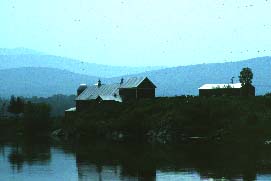 Old
barns are useful and to many people beautiful, and each one is a part of
Vermont's heritage. That doesn't mean every one can be saved, but it does
mean that they should be maintained and reused if it makes sense.
Old
barns are useful and to many people beautiful, and each one is a part of
Vermont's heritage. That doesn't mean every one can be saved, but it does
mean that they should be maintained and reused if it makes sense. TAKING
CARE OF YOUR OLD BARN
Why Save Old Barns?
"It's good to know that
the barn's been repaired. My people worked hard here. So did I. That's
what these barns represent, hard work; long days but good ones. I think
that's why barns are so important to people. Each one has a story to tell."
John Smith, South Newbury, Vermont.
 Old
barns are useful and to many people beautiful, and each one is a part of
Vermont's heritage. That doesn't mean every one can be saved, but it does
mean that they should be maintained and reused if it makes sense.
Old
barns are useful and to many people beautiful, and each one is a part of
Vermont's heritage. That doesn't mean every one can be saved, but it does
mean that they should be maintained and reused if it makes sense.
It often makes good economic sense
to keep barns. They provide valuable storage and work space. They usually
can be adapted to new uses at a much lower cost than building a replacement.
Where budgets are tight, adapting an existing barn rather than building
new can mean the difference between "paying as you go" or paying
interest on a bank loan. Preserving a barn's historic character can go
hand-in-hand with the economic and efficient use of a farm building.
Many owners simply enjoy using and
taking care of their old farm buildings. They appreciate the historic character
of the barns, stables, corn cribs, sugarhouses, and the surrounding landscape.
They respect and value the heritage of their families and other Vermonters
who made and worked these farms.
Taking care of what you already
have, repairing rather than replacing things whenever possible, and replacing
only what needs to be replaced is a tradition on many Vermont farms. It
is also the essence of preserving historic agricultural buildings.
For the last two hundred years farm families have been good stewards selectively keeping and adapting the buildings that represent our history. Our generation now faces the challenge of maintaining this irreplaceable legacy for future Vermonters to use and enjoy.
© 1995 Vermont Division for Historic Preservation and Vermont Housing and Conservation Board. All rights reserved.
Forward to A Short History of Vermont Agricultural Buildings...